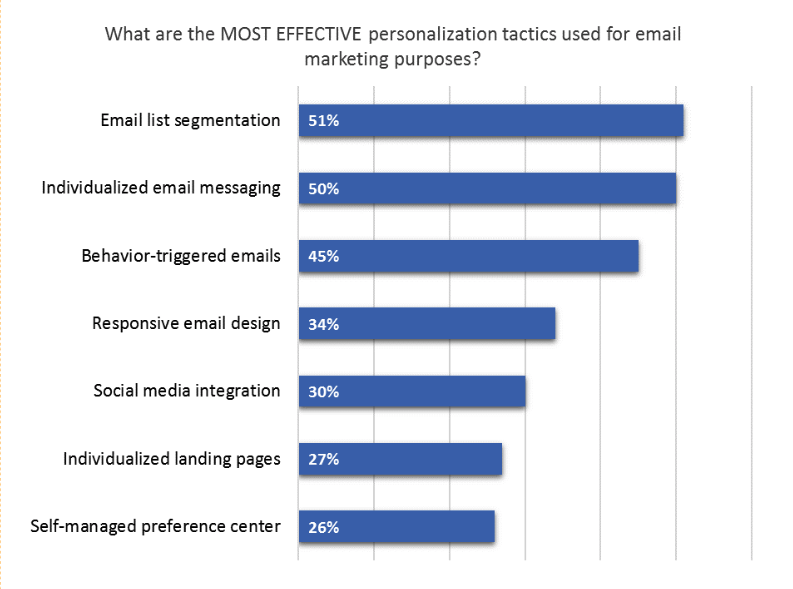7 Fundraising Email Mistakes That You Need to Avoid


Email marketing is one of the most effective and least pricey marketing strategies nonprofits can use to increase donations and donor retention rates. Most organizations, however, still don’t effectively use this powerful fundraising tool for successful donation appeals and campaigns.
According to the 2020 Global Trends in Giving Report, 26% of donors report that emails inspire them to donate, but only 41% of nonprofits send emails to potential donors monthly. Others use email but make many mistakes, ultimately affecting the campaign’s success.
We’ll focus on this second category of nonprofits. If you’re running those email marketing campaigns already, here are seven common fundraising email mistakes and how you can avoid them.
1. Improper Email List Segmentation
Donor email list segmentation involves categorizing different people so you can send them targeted email content. Segmentation will improve your business writing by helping you write email content that will resonate with each recipient. This technique is far more effective than generic email blasts. It will help relate better with your audience, hence increasing donations.
In fact, the majority of email marketers point out that email segmentation and individualized email campaign messaging are the most effective email marketing tactics, at 51% and 50%, respectively.


So, how do you segment your email list? Identify unique similarities within the email list and segment the list based on what you found. You can also use a LinkedIn Chrome extension to find new and verified emails for your new list if you need to add them to your existing list. This will exclude fraud and scams and will guarantee deliverability.
Segmentation can be done using criteria such as the volunteer’s history, age, donation capacity, etc.
You can also get information from individual and organization donors through the donation form you send out during the sign-up process.
Check out this form from the Malaysian Aids Foundation.


The data here, such as donation capacity, can be used to segment donors.
There are tools you can use to segment your email list, too. Keela, for instance, can give you relevant contact insights about your email list. You can then use these insights to craft tailored content and increase the chances of eliciting the desired action in your fundraising appeal.
Before you send your tailored email content, make sure you also verify the email addresses to boost email deliverability.
2. Bad Subject Lines
A successful fundraising email will require a compelling email subject line that describes the donor campaign. A good subject line will pique your recipient’s interest and increase open rates. Unfortunately, many nonprofits either inappropriately use subject lines or don’t use them.
Here are some tips to help you write effective fundraising email subject lines:
- Have personalized subject lines for email recipients
- Have direct and descriptive subject lines
- Keep your subject lines short
- Don’t use excessive punctuation. Too many punctuation marks can make your fundraising email go directly to spam.
- Use an emoji carefully to add some visual pizazz.
- Create a sense of urgency using words like “now” or “important.”
Here’s a compelling email subject line. It’s a good one because it’s personalized. It mentions the recipient’s name. The subject line is also powerful as it communicates the recipient’s possible impact if they join the cause.


You may need to experiment with various subject lines to find the ones that resonate with your donor base. For instance, emojis in the subject line may resonate better with some donors than others.
3. Personalization Mistakes in the Email Body
As I mentioned earlier, email subject line personalization is one way to connect to the real person receiving your fundraising emails. The same concept holds when we’re talking about the email body.
There are many ways you can personalize the email body. You can include the recipient’s details like the first name, company, geographic location, etc. You can also have more relevant email content.
Unfortunately, some organizations make mistakes that cancel the benefits of the personalization technique. For example, an organization may use the wrong gender in the fundraising email.
Therefore, while personalization is critical for boosting donor engagements, implement it correctly. Double-check your emails and make sure they’re well-written for the intended recipient. Doing a quick grammar check before sending the email will also be helpful.
Here’s an example of an email with an excellent personalized body.


The recipient’s name is spelled correctly. The email also has relevant content: it was sent to someone who has already had some form of interaction with the nonprofit.
There’s no one-size-fits-all approach to email body personalization. You may need to test emails before finally getting the one that works. As a starting point, though, refer to your email segments to determine the type of content you should send.
4. Prioritizing Donations over Content
A fundraising email screaming “Donate Now” doesn’t do well for your email fundraising campaign.
However, sharing high-quality content and your compelling story through your emails helps establish trust and a meaningful emotional connection. That means you need to share updates on your organization before asking supporters to donate.
Here’s a great example.


Charity Water shares its project’s impact with donors. Notice that they don’t request a donation in this email. They direct the donors to their website for more helpful content regarding the project. From that website, people can see more appeals for donations.
Another thing you’ll notice when moving from the email to the organization’s website is consistency. The overall brand language, from the tone to the choice of words, remains consistent across all the organization’s communication channels.
Why is that important? Consistency builds trust with your audience. Existing and interested donors will always know what to expect from you. That helps them connect with your organization at a deeper level. It’s, therefore, that you create a style guide for your team. One that aligns with your organization’s mission statement and values. The guide should be used across all your communication channels to maintain consistency.
5. Not Optimizing for Mobile Devices
We live in an era where mobile phones are used to doing almost everything, including checking emails. So not optimizing your email templates for mobile devices lowers your open and click-through rates.
There are many things you should consider for effective mobile email marketing. If you’re using fundraising email templates, use those optimized for mobile use. Also, avoid using subject lines with more than 30 characters so the recipient can read them through the phone. You should also have a compelling header text with 40-50 characters to complement the email body.
Use an image size and text that’s compatible with the mobile view. Your call to action button should also be visible.
Here’s an example of The United Methodist Children’s Home email in mobile view.


Notice that the text is easily readable, and the CTA button stands out. Before you send your emails, it’s always a good idea to check how they look on a mobile screen. Make adjustments to the email depending on what you see.


Improve Your Donation Page with this FREE Checklist
This checklist covers elements of your donation pages that you need to optimize to give your nonprofit the best chance at online fundraising success.
6. Sending Too Many Emails
Sending too many emails increases the chances of potential donors blocking emails from your nonprofit.
Email platforms such as Gmail determine the usefulness of an email based on the click-through rate or open rate. Among other things, spam fundraising emails will strain the credibility of your email address and deliverability.
Here are some emailing tips you should consider to help you find that sweet spot on how frequently you should be sending emails for your fundraising appeal:
- Create a consistent sending schedule depending on essential metrics such as open rates, CTR, unsubscribe rates, and conversation rates
- Pay attention to the day and time you’re sending emails to donors. You’ll need to experiment with your audience to identify the best time for your nonprofit to send emails.
- Consider sending a simple donor survey asking how frequently your donor audience would want to hear from you.
It may be tempting to send more emails to collect more online donations for your cause. Unfortunately, too many emails tend to be annoying to most people. Therefore, adopt an intelligent strategy. Send emails only at the most reasonable time. That can help you get the desired results without damaging your email deliverability.
7. Lack of Opt-Out and Unsubscribe Options
It might seem a little tempting to send dozens of emails without permission. However, that would violate the CAN-SPAM act. The act also makes it compulsory for the email sender to give the email subscriber the option to unsubscribe. Including this option makes your organization look transparent and trustworthy.
Secondly, the unsubscribe button gives you feedback on how your campaigns perform. Analyzing an email that triggered a high unsubscribe rate can tell you what doesn’t work with your donors. That helps you improve your future campaigns.
Therefore, do what other reputable organizations do and include the unsubscribe buttons at the bottom of your emails:


Make sure the ‘Unsubscribe’ option is visible. That will help build trust between you and your donors.
Many businesses use email marketing. Nonprofits can also benefit from this marketing strategy. However, you’ll need to steer clear of mistakes that could negatively affect your email fundraising campaigns.
Learn How to Send Personalized Emails with Keela
Get a glimpse of how Keela’s email marketing tool can help you to build and send engaging fundraising emails to your donors and supporters.
You learned seven such mistakes and how to avoid them. Avoid improper email list segmentation and lousy email subject lines. Don’t send emails with irrelevant content or emails that only prioritize soliciting donations. Finally, don’t send too many emails and ignore mobile optimization.
Follow all these, and you’ll write better fundraising emails to help you achieve your fundraising goals.
Good luck!


About the author:
Nicholas Rubright, Communications Specialist for Writer
Nicholas Rubright is the communications specialist for Writer, an AI writing assistant designed for teams. Nicholas has previously worked to develop content marketing strategies for brands like Webex, Havenly, and Fictiv.





